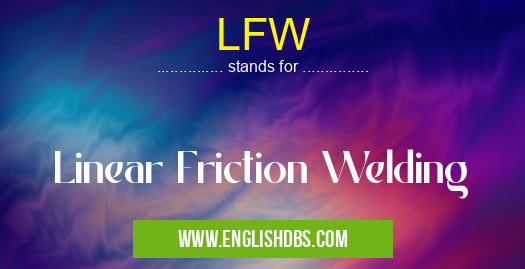What does LFW mean in UNCLASSIFIED
LFW stands for Linear Friction Welding, a solid-state welding process that joins two metal workpieces by generating heat through friction while applying a linear motion. Unlike traditional welding methods that involve melting the metal, LFW produces a solid-state bond by frictionally generating heat and pressure.

LFW meaning in Unclassified in Miscellaneous
LFW mostly used in an acronym Unclassified in Category Miscellaneous that means Linear Friction Welding
Shorthand: LFW,
Full Form: Linear Friction Welding
For more information of "Linear Friction Welding", see the section below.
Process
In LFW, one workpiece is held stationary while the other is moved in a linear motion, creating friction between the surfaces. The friction generates heat, which softens the metal without melting it, forming a solid bond when the pressure is released. The process is typically performed in a controlled environment to ensure precise alignment and prevent oxidation.
Advantages
- High-Strength Joints: LFW produces strong and reliable joints with a high weld strength and integrity.
- No Melting: As LFW does not involve melting, it eliminates the risk of solidification defects and ensures a consistent weld quality.
- Limited Heat Distortion: The localized nature of heat generation minimizes heat distortion and warping, preserving the dimensions of the workpieces.
- Versatility: LFW can be used to join a wide range of metals, including steel, aluminum, titanium, and copper alloys.
- Automation: LFW is highly automated, allowing for consistent and repeatable welds with minimal manual intervention.
Applications
LFW finds extensive applications in various industries, including:
- Aerospace
- Automotive
- Medical
- Construction
- Electrical
Essential Questions and Answers on Linear Friction Welding in "MISCELLANEOUS»UNFILED"
What is Linear Friction Welding (LFW)?
LFW is a solid-state metal joining process that utilizes friction heat and forging pressure to create a bond between two metal surfaces without melting them. It is a highly efficient and cost-effective method for joining similar or dissimilar metals, offering strong and reliable connections.
How does LFW work?
LFW involves rotating one metal component while linearly moving the other component against it, creating friction and heat. This heat softens the metal surfaces, allowing them to deform and interlock under the applied forging pressure. The process continues until a solid-state bond is formed between the two components.
What are the advantages of LFW?
LFW offers several advantages, including:
- High strength and fatigue resistance due to the creation of a solid-state bond
- Minimal material loss and distortion
- Ability to join dissimilar metals that cannot be joined by other methods
- Fast and efficient process, reducing production time and costs
What are the limitations of LFW?
Like any other joining process, LFW has certain limitations:
- Requires precise control of friction heat and forging pressure to prevent damage to the components
- Can be sensitive to surface preparation and cleanliness
- May not be suitable for joining very thin or brittle materials
What industries use LFW?
LFW is widely used in various industries, including:
- Automotive: Joining of steering components, drive shafts, and suspension systems
- Aerospace: Assembly of aircraft frames and landing gears
- Medical: Fabrication of surgical instruments and prosthetics
- Energy: Construction of wind turbine components and oil and gas pipelines
What are some key factors to consider when using LFW?
When using LFW, it is important to consider several key factors, such as:
- Material compatibility and surface preparation
- Optimization of friction heat and forging pressure
- Tool design and maintenance
- Quality control and process monitoring
How does LFW differ from other welding techniques?
LFW differs from other welding techniques in several ways:
- It does not require melting of the metals, resulting in a solid-state bond.
- It generates less heat, minimizing distortion and material loss.
- It can join dissimilar metals that cannot be welded using traditional techniques.
- It is a faster and more cost-effective process compared to other welding methods.
Final Words: LFW (Linear Friction Welding) is an advanced welding process that offers numerous advantages over traditional welding methods. By generating heat through friction and applying pressure, LFW creates high-strength, solid-state bonds with minimal heat distortion and oxidation. Its versatility and automation make it an ideal solution for a wide range of applications requiring reliable and precise welding.
